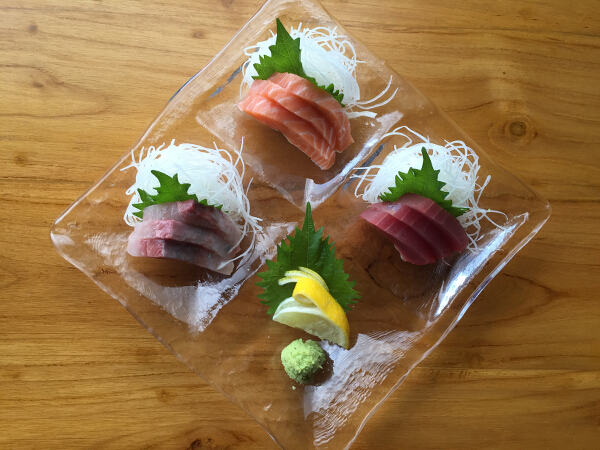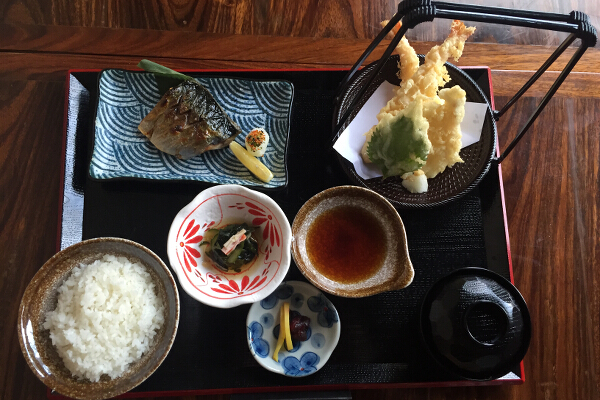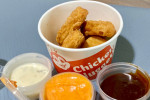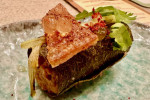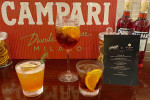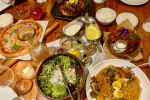Booth seats and Ushio Sekiguchi’s Japanese wallpaper
My boyfriend loves Japanese food, so I’m always on the lookout for Japanese restaurants I can take him to whenever he’s in Manila. And while we’re both open to the many Japanese fusion restaurants that seem to be more popular these days, he seems to prefer those that serve traditional Japanese cuisine, and that’s something that isn’t as common around here. I always ask friends for their suggestions, and now there’s a new one to try in Fort, which opened just last October 8, 2015: Ogawa, a traditional Japanese restaurant located at the second floor of The Fort Entertainment Complex in BGC.

This new restaurant is a collaboration between food connoisseur and businessman George N. Pua of No Limits Food, Inc. and renowned Japanese Chef Kiyoshi Ogawa, as they share the same dream of wanting to let Filipinos experience how high quality Japanese cuisine really tastes like. It promises to give diners a distinctly ancient dining experience, where we can savor and experience true Japanese flavor in our local shores.

Even Ogawa’s 100-year-old antique main door brought in from Japan and installed at the reception area (above) embodies the naturalness and heritage that the restaurant upholds. The restaurant has five elegantly designed private dining rooms perfect for business meetings, intimate get-togethers, or birthday celebrations. The rooms were named after distinct cities in Japan: Ginza, Roppongi, Akasaka, Aoyama, and Shinbashi. Click through the gallery below for a virtual tour of the interiors of Ogawa.
The Japanese wallpaper by Ushio Sekiguchi also creates a natural atmosphere, as the layout of pine trees, leaves, branches, and sparrows seemingly create a natural landscape on the walls.
Robatayaki and Teppanyaki Station
The main counter (above), where the dishes are set to be served to guests, is patterned after “Mikoshi,” a traditional festival, since it’s like the main stage of Chef Ogawa. This is where I sat to get a front-row seat to the chefs’ action. The sushi station (below), on the other hand, is created with a sense of space to beautifully present the art of sushi. You can also sit here, or choose one of the booths so you have more space and privacy.
Among their menu offerings are Teppanyaki (Wagyu and a la carte), with meat, seafood, and vegetables cooked and seared on an iron girdle; the traditional multi-course Japanese dinner Kaiseki; and the original Japanese barbecue, Robatayaki (charcoal-grilled skewers), paired exquisitely with the Japanese staple, Sushi (Moriawase and Nigiri, Tokyo Style) and Sashimi, with ingredients imported from Japan. They also offer Maki/Temaki (rolled and hand-rolled sushi), Tempura, and Agemono.
Three types of Sashimi
I was only able to try two dishes that both happen to be meal sets. At the opening event, they made us pick from a fish bowl what dish we would be served, and the piece of paper read “Gyunabe Lunch,” P480 (below). It includes an appetizer, salad, beef and vegetables hotpot, rice, miso soup, pickles, and dessert. The choices for dessert are coffee jelly or a scoop of ice cream, with the following available flavors: vanilla, black sesame, matcha, and chocolate. I went with the chocolate ice cream, and I’m glad I did because it’s so yummy and creamy!
Their miso soup is light tasting, flavorful, has the right balance of saltiness and acidity, and effectively warms the tummy. The hotpot likewise has the same effect, but its broth is sweet, with transparent noodles. There’s a generous helping of vegetables in the hot pot, which includes mushrooms, greens, tofu, carrots, and onions, but not as much meat as I’d like. I wish there was more of the US beef, which is really tender, juicy, and so flavorful, I enjoyed eating it with my Japanese rice—it was gone too soon.
The other meal set I tried is Tempura To Yakizakana, P430 (below). It includes an appetizer, prawn and kizu tempura, grilled fish (gindara), rice, miso soup, pickles, dessert. The prawn tempura batter had good flavor, and the tempura sauce is not too sweet and savory enough. The grilled gindara was complemented well by the teriyaki sauce it was marinated in, and it’s nicely smoked and well-cooked, but watch for huge tinik (fish bones), eek!
If you just want an a la carte order of tempura, there’s Ebi Tempura Moriawase (Prawn Tempura with Vegetables) at P370, as well as Ebi Tempura (just Prawn Tempura) at P290 for 3pcs and P580 for 6pcs.
I paired both meals with their iced tea, which doesn’t taste like your usual iced tea, so I’m assuming they used traditional tea for this as well.
I feel I must remind you, however, that the restaurant is still on its soft opening (it only opened last week), so the service staff still needs to get used to the volume of people that comes in, especially when it comes to answering questions about the dishes and in their response time to requests, like tissue, water, the menu, and the like. Let’s exercise more patience, even when we have to request for things three or four times before they are given.
Ogawa Traditional Japanese Restaurant is located at the 2nd floor (of Tony Roma’s) of The Fort Entertainment Complex, Fort Strip, 5th Ave. corner 28th St. BGC, Taguig City. For inquiries and reservations, you may contact +632-886-4994 or 0917-85-OGAWA. To know more about Ogawa Traditional Japanese restaurant, visit its website.























